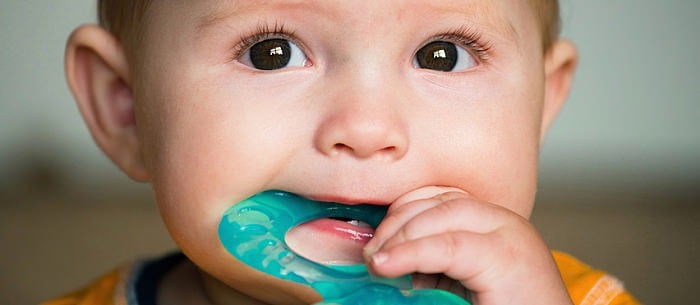Parents and caregivers know that teething can cause many different ailments for little ones, from mouth pain to interrupted sleep. But did you know teething can also cause a rash so common it’s known as “teething rash?” This rash can appear at any time during teething, and can last well into toddlerhood.
Though only a medical professional can officially diagnose this type of rash, there are several things parents and caregivers can do to both recognize and treat this very common type of skin ailment at home.
What Is Teething Rash?
Although this skin issue is known by many parents and caregivers as a “teething rash,” most medical professionals use the broader term “drool rash” to describe this malady. “Some babies get a little more drooly when they are teething — though in fact, many babies have plenty of drool even when they’re not teething, too!” says pediatrician Dr. Roy Benaroch, the creator of Pediatric Insider and author of “Solving Health and Behavioral Problems from Birth through Preschool.” “In any case, drool can sometimes contribute to a rash on the chest and neck, from macerated, wet skin, [which is] sometimes called a teething rash.”
Because drool can get on the neck and chest, a rash can develop in both these areas. This rash often consists of red splotches and bumps and can be foul-smelling as well. Dr. Benaroch notes that this rash can look a little bit different depending on where it is located. “The neck rash can look like intertrigo or a yeast infection, and the chest rash can look somewhat like eczema.”
Treatment and Prevention
Once you’ve identified the source of your baby’s rash, there are several ways you can treat it. Dr. Tanya Altmann, a pediatrician and parenting author, says that parents should apply “a thin coat of petroleum jelly or Aquaphor [to] protect the skin as well as to treat irritation.” To prevent further skin damage, Dr. Altmann suggests parents and caregivers “always use a mild unscented baby wash [during bath time], followed by unscented moisturizer on dry areas.” To prevent the rash from forming, wipe up excess drool as often as you can and keep the skin dry.
When to See a Pediatrician
Though most instances of drool and teething rash are relatively minor and go away with regular treatment at home, there are some instances when a pediatrician should be seen. Dr. Altmann recommends calling your doctor “if the rash isn’t improving with over-the-counter baby cream or Aquaphor, or is red, weepy, cracked or painful.” If you see any of these developments, make an appointment as soon as you can, as doctors can order prescription-strength creams that can help the rash heal faster and help relieve any pain your little one might be feeling as a result.
Though this type rash can be a pain for you and your baby to deal with, this is an ailment that is typically easy to treat and often goes away after a few weeks of home treatment. Though there are some cases where this rash can develop into something more serious, in most cases drool and teething rash is one issue that may look like a big deal but is actually fairly manageable for both baby and parent.
Amanda Kondolojy is a full-time freelancer with more than a decade of caregiving experience.
* This article is for general informational purposes only. It is not intended nor implied to be providing medical advice and is not a substitute for such advice. The reader should always consult a health care provider concerning any medical condition or treatment plan. Neither Care.com nor the author assumes any responsibility or liability with respect to use of any information contained herein.
